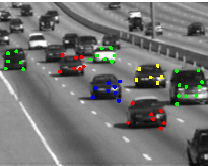
Automated Vehicle Detection and Tracking
Traffic counts, speed, and vehicle classification are fundamental data for a variety of transportation projects ranging from transportation planning to modern intelligent transportation systems (ITS). Most ITS applications are designed using readily available technology such as the inductive loop detectors, radar, infrared (IR), lasers, ultrasonic sensors, or magnetometers. Since the late 1980s, video detection systems have been marketed in the U.S. and elsewhere. Most popular video based traffic counting systems use high-angle cameras to count traffic by detecting vehicles passing digital sensors. The accuracy of such systems is compromised if the cameras are mounted too low or have poor perspective views of traffic, in which case the image of a vehicle "spills over" onto neighboring lanes, resulting in double counting. Mounting cameras at much lower heights than is currently required would make the deployment of such technology much more affordable and hence widespread, and would solve a number of aesthetic and practical issues as well. This project developed automated techniques for detecting and tracking vehicles in challenging low-angle imagery, even in the presence of severe occlusion. Web LinkVehicle Tracking Project Web Page Publications
|